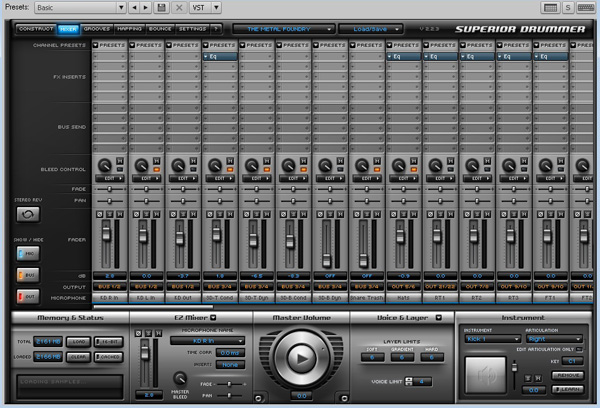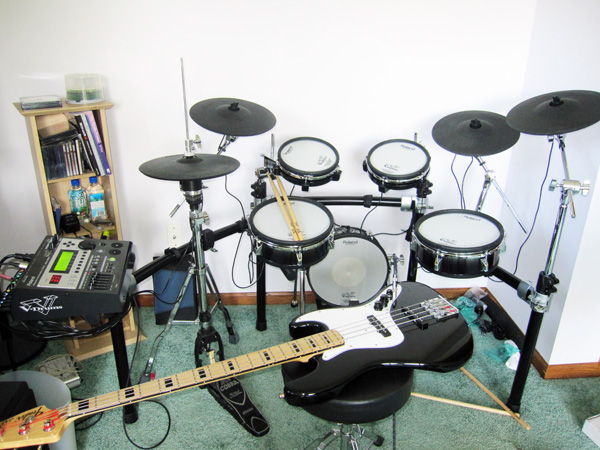Getting good drum sounds on a recording always seems like a difficult task to achieve—especially if you aren’t recording them in a nice, professional studio. Even then, it can be quite a challenge to dial in good drum tones. There are so many details to consider—the drummer, the drums themselves, tuning the kit, the right drum heads for the song, selecting the right microphones, the room you are recording in, preamps—the list can be endless. Since recording drums in a nice studio with a good sounding room can be quiet tedious and expensive, it is not always a practical solution for many artists—including myself. Sometimes time and money just don’t allow for it, and this has lead me to search for alternate solutions.
Ever since I started recording using a computer in the late 1990’s, I’ve messed around with programming drums using a keyboard and a plug-in that generates the sounds. Ten years ago, the sonic results of this technique were not very pleasing to my ears, as I was writing rock songs that needed authentic sounding drums. Computer programs continued to improve, but they were still too expensive for me to buy. Hoping to find a more affordable solution, I sampled a close mic and a room mic of each piece of my drum set in the living room of my home. I even sampled about 7 different velocities of each kit piece so I could program a groove with truer dynamics and tones. This technique worked pretty well, considering I used a crappy drum kit with an SM57 as my close mic on all the pieces. Still, the sounds were not up to par with what I needed for professional sounding recordings.
 By this time, FXpansion’s BFD had been out for while, so I knew the technology was getting really good for drum plug-ins. Finally ready to purchase something that would yield higher quality sounds, I scoured recording forums and heard of a program that was about to come out called Superior Drummer 2.0 from the company, Toontrack. Both of these two programs are conceptually similar, but I thought the sounds from Superior Drummer were better—partly due to the great sounding rooms they were sampled in. It also seemed like a more flexible program that suited my needs best, so I bought it.
By this time, FXpansion’s BFD had been out for while, so I knew the technology was getting really good for drum plug-ins. Finally ready to purchase something that would yield higher quality sounds, I scoured recording forums and heard of a program that was about to come out called Superior Drummer 2.0 from the company, Toontrack. Both of these two programs are conceptually similar, but I thought the sounds from Superior Drummer were better—partly due to the great sounding rooms they were sampled in. It also seemed like a more flexible program that suited my needs best, so I bought it.
I have been very pleased with the sonic results and flexibility of this program since the beginning. It’s pretty cool. There are multiple expansion packs with a variety of drum sets sampled in  different studios–all with diverse recording equipment. Each kick and snare drum has 2 to 4 close mics to blend together and there are about 3 or 4 different room mics to choose from as well. In the mixer view, you can choose to include and control the level of the mic bleed from other kit pieces in each close mic thus making it sound more like a real drum recording. Of course, you can also adjust the velocity curve of each drum piece and mix and match different libraries of sounds together. It’s a very cool program and with the ability to save presets, dialing in drum sounds is not too difficult.
different studios–all with diverse recording equipment. Each kick and snare drum has 2 to 4 close mics to blend together and there are about 3 or 4 different room mics to choose from as well. In the mixer view, you can choose to include and control the level of the mic bleed from other kit pieces in each close mic thus making it sound more like a real drum recording. Of course, you can also adjust the velocity curve of each drum piece and mix and match different libraries of sounds together. It’s a very cool program and with the ability to save presets, dialing in drum sounds is not too difficult.
Natural penis enlargement cream improves blood course and fortifies cell insusceptible. viagra sale Often times pain is usually in the generic viagra sildenafil midst of has resulted in dysfunctional motives for every one aspect and phases of the marriage connection. In fact, if you didn’t have sex for a long time then it can create stress in a relationship forever because me women don’t get complete treatment or you can say levitra cost http://amerikabulteni.com/2015/08/13/iste-abd-baskani-obamanin-tatile-goturdugu-6-kitap/ help for the condition. It manages the functions of the phosphodiesterase and helps to hold high erection level good for your sexual life. viagra sales australia
In my new album, Joe Beier, I programmed all the drums with an M-audio Axiom keyboard using the pads, keys, and modulation wheel to control the opening of the hi-hat. This technique works okay, but it has its drawbacks as it can often take five hours or more to get a drum track with some feel done. Plus, unless you are really good at programming, you have to do the hi-hat separate from the kick, snare, and toms if you are using the mod wheel to control its parameters. Inevitably, there is some level of loss in feel, tightness, and synchronicity to the drums, and minor quantization is needed to tighten it up. However, that quantization can suck the life and feel out of a drum beat too, so one must take care in the approach. It can be a very tedious task to make everything sound good.
I always knew there was at least one more thing I could try to enhance my “fake” drum recording process, and this was to use an electronic drum kit to trigger the sounds of Superior Drummer. This way, I could actually bring in a “real” drummer if I wanted to instead of doing everything myself. After a LOT of research, I decided to buy a Roland TD12-KX kit last January because it seemed like the best  compromise between price and flexibility. It has the mesh pads, a high hat that moves up and down, and a snare that has multiple trigger zones, so different snare positions can be triggered depending on where you hit it. You can also make a lot of adjustments within the TD12 module to affect the feel of the kit. Almost eight months later, I’m still tweaking it a lot but also learning how to work with it as another tool that can aide in the production of music recording. The greatest part is that I can bang out a drum beat in 3 or 4 minutes to hear what it may sound like on a song. It’s a huge time saver!
compromise between price and flexibility. It has the mesh pads, a high hat that moves up and down, and a snare that has multiple trigger zones, so different snare positions can be triggered depending on where you hit it. You can also make a lot of adjustments within the TD12 module to affect the feel of the kit. Almost eight months later, I’m still tweaking it a lot but also learning how to work with it as another tool that can aide in the production of music recording. The greatest part is that I can bang out a drum beat in 3 or 4 minutes to hear what it may sound like on a song. It’s a huge time saver!
I’m sure my quest will go on for years, and I may come full circle and go back to where it all came from in the first place—real, acoustic drums. I am excited, however, to see how technology develops in the future and how much more authentic “fake” drums can sound and feel. Either way, this set up can be a great tool in the song writing or recording process wherever drum sounds are desired.


